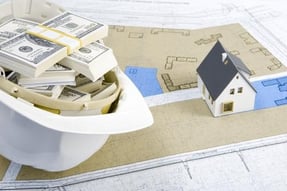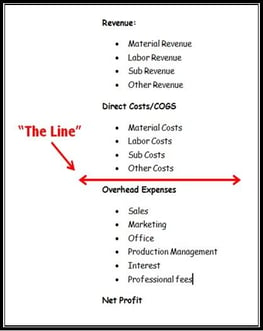3 Financial Strategies for a More Scalable Construction Business
 As 2017 dawns, the outlook for the construction industry is optimistic. Despite setbacks experienced during the Great Recession, the industry is set to add 790,400 jobs over the decade of 2014 to 2024, accounting for the majority of new jobs in the goods-producing sector. Real output will grow 2.8 percent annually during this period. In 2017, total U.S. construction starts will increase 5 percent, reaching $713 billion, anticipates Dodge Data & Analytics.
As 2017 dawns, the outlook for the construction industry is optimistic. Despite setbacks experienced during the Great Recession, the industry is set to add 790,400 jobs over the decade of 2014 to 2024, accounting for the majority of new jobs in the goods-producing sector. Real output will grow 2.8 percent annually during this period. In 2017, total U.S. construction starts will increase 5 percent, reaching $713 billion, anticipates Dodge Data & Analytics.
For contractors, this is great news, but it also presents the challenge of scaling up to meet growing demand. Scaling up requires not only hiring more workers and buying more material, but also adjusting your financial strategy to cover your increased overhead expenses without hurting your cash flow and profits. Here are three financial strategies for successfully scaling up in 2017.
Scale up Revenue while Scaling Down Costs and Expenses
A scalable remodeling business model is designed to allow you to increase revenue while holding both job costs and overhead expenses down. To be scalable, your financial plan should aim for gross profit margins of 40 percent or more (minimum of a 1.67 markup).
 To achieve this level of gross profit margin, one fundamental strategy is increasing your revenue. The key to increasing your revenue is improving your marketing and sales. One of the most efficient ways to improve your marketing is by improving your positioning through a better unique selling proposition (USP): a brief statement that summarizes what you offer customers that your competition doesn’t.
To achieve this level of gross profit margin, one fundamental strategy is increasing your revenue. The key to increasing your revenue is improving your marketing and sales. One of the most efficient ways to improve your marketing is by improving your positioning through a better unique selling proposition (USP): a brief statement that summarizes what you offer customers that your competition doesn’t.
To refine your USP, narrow down your ideal target market. For instance, is there a certain neighborhood or a certain type of building that would be more profitable to specialize in? Research what your target market is most seeking in a construction contractor. For example, are they price shoppers or are quality or service bigger priorities for them? Craft your USP to emphasize what your target market most values and make sure all your marketing material reflects your new USP.
Along with increasing your revenue, the other half of keeping a high profit margin is keeping expenses low. Many construction businesses fail because they can’t cover the cost of overhead. Finding ways to reduce the money you must pay for running your business is key to minimizing your expenses. Taking the time to research different organizational charts, industry best practices, project management methods, business management software and employee compensation strategies based on performance. Investing in these areas now can help your business reduce overhead through efficiency of operations as well as economy of scale as the business grows.
Maintain Efficiency through Automation
 Another effective strategy to lower job costs is automation. Automation can help you lower the costs of materials by helping you plan more precisely to avoid unnecessary waste. J.E. Dunn has partnered with Autodesk and Microsoft to develop Lens, a cloud-based software tool that combines 3-D virtual modeling with instantly-calculated cost estimates for each component of your building project.
Another effective strategy to lower job costs is automation. Automation can help you lower the costs of materials by helping you plan more precisely to avoid unnecessary waste. J.E. Dunn has partnered with Autodesk and Microsoft to develop Lens, a cloud-based software tool that combines 3-D virtual modeling with instantly-calculated cost estimates for each component of your building project.
Although not common yet in residential remodeling, another way automation can help cut materials costs and waste is by using 3-D printing. 3-D printing allows you to select from a wider range of cost-efficient materials, while speeding up the building process. Last year, Chinese company Huashang Tengda was able to assemble a 3-D-printed house in just 45 days. Remember, many said nail guns would never catch on!
Keep Costs and Expenses Down with Outsourcing
 Outsourcing is another proven way to cut labor costs both in the field as well as the office. Many successful large companies outside our industry have used outsourcing effectively to streamline their labor expenses. For instance, Google relies heavily on revenue from pay-per-click advertisers who pay to have their results featured in search engine rankings. Maintaining its advertising revenue requires a large sales support team, which Google has outsourced. Amway is another company that outsources its sales, relying on a distributor model to promote direct sales. In our industry many contractors already outsource activities such as design, engineering, building permit procurement, sales, lead intake and prequalification, RRP demo, specialty trades and even general carpentry.
Outsourcing is another proven way to cut labor costs both in the field as well as the office. Many successful large companies outside our industry have used outsourcing effectively to streamline their labor expenses. For instance, Google relies heavily on revenue from pay-per-click advertisers who pay to have their results featured in search engine rankings. Maintaining its advertising revenue requires a large sales support team, which Google has outsourced. Amway is another company that outsources its sales, relying on a distributor model to promote direct sales. In our industry many contractors already outsource activities such as design, engineering, building permit procurement, sales, lead intake and prequalification, RRP demo, specialty trades and even general carpentry.
As these examples illustrate, you can outsource functions that are part of your core business if it is more efficient to delegate them to specialists than to maintain in-house talent. For instance, there is no need to pay for the expense of in-house 3-D drafting when you can easily outsource it. With the right plan and system you can also easily outsource routine peripheral functions such as bookkeeping and payroll.


 Are you pretending to be a remodeling business owner but in reality you are actually just a "job owner"? The questions below are tough and may make you feel real bad about yourself depending on how you answer them. But that’s not why I assembled them. Don’t kid yourself. If you are not cut out to be a business owner recognize that reality now. Don’t wait until you lose you all your money, your home and maybe even your family. If being in business is not your calling keep in mind the industry is desperate for good employees. Real remodeling business owners offer good jobs with great pay and benefits. Answering these questions might just be the best thing you do for yourself this year.
Are you pretending to be a remodeling business owner but in reality you are actually just a "job owner"? The questions below are tough and may make you feel real bad about yourself depending on how you answer them. But that’s not why I assembled them. Don’t kid yourself. If you are not cut out to be a business owner recognize that reality now. Don’t wait until you lose you all your money, your home and maybe even your family. If being in business is not your calling keep in mind the industry is desperate for good employees. Real remodeling business owners offer good jobs with great pay and benefits. Answering these questions might just be the best thing you do for yourself this year. Are you one of those business owners who doesn't know the difference between markup and margin, or worse you think they mean the same thing (WAG)?
Are you one of those business owners who doesn't know the difference between markup and margin, or worse you think they mean the same thing (WAG)?
 OK, I’m sick and tired of the foo-foo fluffy BS answers some magazines and bloggers put out there to answer how contractors can raise their markup. All the BS answers I see offered by others never call these contractors out on their ignorance. Without knowing what markup they actually need to use how would a contractor who is “slowly raising” his markup know when he has finally hit the right markup? It drives me crazy! If you are ready for the no BS answers read on…
OK, I’m sick and tired of the foo-foo fluffy BS answers some magazines and bloggers put out there to answer how contractors can raise their markup. All the BS answers I see offered by others never call these contractors out on their ignorance. Without knowing what markup they actually need to use how would a contractor who is “slowly raising” his markup know when he has finally hit the right markup? It drives me crazy! If you are ready for the no BS answers read on…
 Many remodelers determine their pricing structure by copying what other businesses do rather than figure out what markup their business actually needs to use. Comparing or copying markups or margins is pointless and very risky without knowing how they were determined. The decision about what costs or expenses go above or below the gross profit line can be different at different remodeling companies. Therefore the markup each company will need to use to cover overhead costs and planned net profit will be different. Let me explain and clarify.
Many remodelers determine their pricing structure by copying what other businesses do rather than figure out what markup their business actually needs to use. Comparing or copying markups or margins is pointless and very risky without knowing how they were determined. The decision about what costs or expenses go above or below the gross profit line can be different at different remodeling companies. Therefore the markup each company will need to use to cover overhead costs and planned net profit will be different. Let me explain and clarify. First, here are the terms you need to know
First, here are the terms you need to know It also important to know that fewer than 20% of remodelers actually know the true costs of being in business. That means that 80% or more are using what has been referred to as the WAG or “Wild Ass Guess” method when it comes to deciding what markup they use to price the projects they sell. I call that
It also important to know that fewer than 20% of remodelers actually know the true costs of being in business. That means that 80% or more are using what has been referred to as the WAG or “Wild Ass Guess” method when it comes to deciding what markup they use to price the projects they sell. I call that  So, what about you and your business?
So, what about you and your business? I often hear contractors say they offer fair pricing. When I ask them what they mean by that most really can't provide a logical answer, or their answer is subjective. It got me to thinking about what fair pricing really is. I came up with three considerations I think make a contractor's pricing fair to their customers, but also to their business as well as their employees. Let me know what you think.
I often hear contractors say they offer fair pricing. When I ask them what they mean by that most really can't provide a logical answer, or their answer is subjective. It got me to thinking about what fair pricing really is. I came up with three considerations I think make a contractor's pricing fair to their customers, but also to their business as well as their employees. Let me know what you think. I would suspect most contractors work for customers who have good jobs offering decent pay for the job performed, workers compensation coverage, benefits like vacation and holiday pay so they can enjoy life, health insurance so they can stay healthy and retirement contributions so they can save for a comfortable retirement. I bet if their employers took any of those things away from them “it wouldn’t be fair”.
I would suspect most contractors work for customers who have good jobs offering decent pay for the job performed, workers compensation coverage, benefits like vacation and holiday pay so they can enjoy life, health insurance so they can stay healthy and retirement contributions so they can save for a comfortable retirement. I bet if their employers took any of those things away from them “it wouldn’t be fair”.
 Well before attempting to break past $Million in installed sales remodelers and home improvement contractors should already have an established and tested sales system in place. The system should be well defined. Those involved with selling, as well as supporting the sales department at your business, must be trained and held accountable to using it correctly and consistently.
Well before attempting to break past $Million in installed sales remodelers and home improvement contractors should already have an established and tested sales system in place. The system should be well defined. Those involved with selling, as well as supporting the sales department at your business, must be trained and held accountable to using it correctly and consistently.  Decide what Sales System you will use
Decide what Sales System you will use I want to stress that consistency of and with your company's sales approach will be really important as the business grows. Without consistency it will be difficult for the owner to become a sales manager, or transfer sales management to someone else, because each sales person may approach selling in a different way. And, without consistency of sales approach, repeat customers and their referrals may not experience what they expected when a new salesperson visits them. Plus, by having a consistent sales approach that successfully helps prospects buy the right solution, you can market the advantages of that sales system with confidence prospects will experience what they expect if they respond you your marketing.
I want to stress that consistency of and with your company's sales approach will be really important as the business grows. Without consistency it will be difficult for the owner to become a sales manager, or transfer sales management to someone else, because each sales person may approach selling in a different way. And, without consistency of sales approach, repeat customers and their referrals may not experience what they expected when a new salesperson visits them. Plus, by having a consistent sales approach that successfully helps prospects buy the right solution, you can market the advantages of that sales system with confidence prospects will experience what they expect if they respond you your marketing.

 Not knowing the true costs of being in business as your business grows and being surprised about the costs when the bills come in.
Not knowing the true costs of being in business as your business grows and being surprised about the costs when the bills come in.


 Be the leader you need to be. Work on your leadership skills and make sure you understand the difference between leadership and management, and when to use one versus the other. Good employees want to be lead, not supervised.
Be the leader you need to be. Work on your leadership skills and make sure you understand the difference between leadership and management, and when to use one versus the other. Good employees want to be lead, not supervised. Know your limits. Do what you can yourself but get the professional help you need to do things right; to avoid costly mistakes, increase the likelihood of success and maximize the results for your all your efforts.
Know your limits. Do what you can yourself but get the professional help you need to do things right; to avoid costly mistakes, increase the likelihood of success and maximize the results for your all your efforts.
 Try to get your clients to make their selections during the design phase.
Try to get your clients to make their selections during the design phase.

 Here are a few times when saying nothing might just be the best thing to say:
Here are a few times when saying nothing might just be the best thing to say:
 A good number of contractors at one time or another find themselves in a financial hole. Rather than figure out how they got there, they just keep working, often assuming by working harder or longer hours they will eventually get out of the hole. Unfortunately many of them just dig a deeper hole and eventually the hole is so deep they can’t climb out so they stay in it. Sometimes the hole can even cave in all around them and bury them and their businesses. If you want to avoid the most common reasons contractors get into financial trouble
A good number of contractors at one time or another find themselves in a financial hole. Rather than figure out how they got there, they just keep working, often assuming by working harder or longer hours they will eventually get out of the hole. Unfortunately many of them just dig a deeper hole and eventually the hole is so deep they can’t climb out so they stay in it. Sometimes the hole can even cave in all around them and bury them and their businesses. If you want to avoid the most common reasons contractors get into financial trouble 






